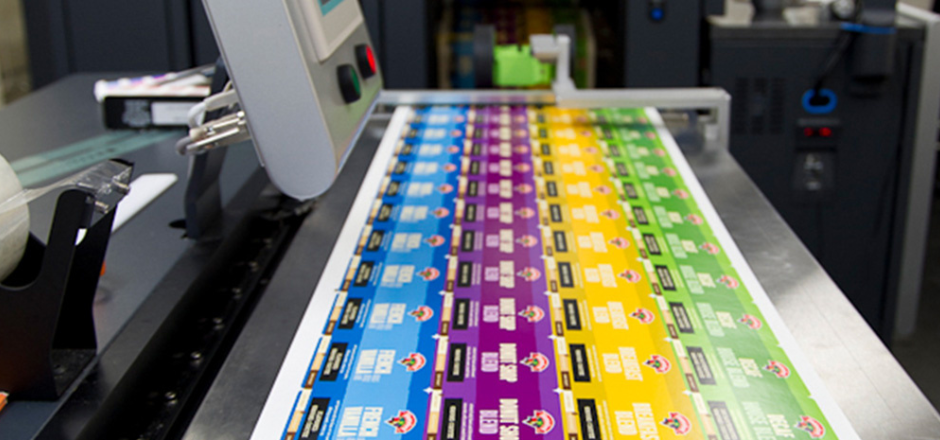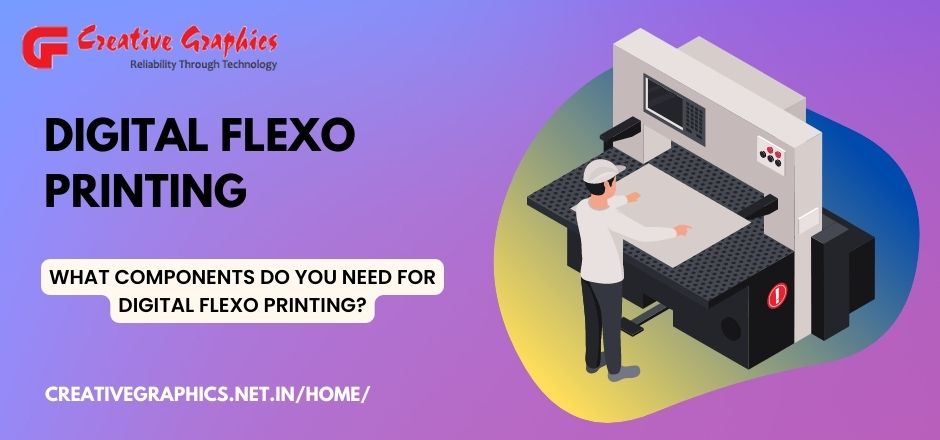What Components Do You Need for Digital Flexo Printing?

How To Choose a Flexographic Printing Plate (In 2022)?
June 25, 2022
A Step-by-Step Guide to Flexography on How Flexographic Printing Works
June 29, 2022If you’re reading this, you’re probably already familiar with flexographic printing, which uses cylinders and elastomer sleeves to print at high speeds on various substrates while maintaining high quality.
But did you know that there is a digital flexographic printing option that uses sensors and automation to improve consistency and colour accuracy, precisely reproducing any unique Pantone colour from the extended gamut on every print run?
Flexo printing is a type of print production where the final printed piece has an embossed or raised effect. It’s commonly used for labels and packaging, but also for other applications. Digital flexo printing involves using computer-controlled cutting machines to cut out the design from a sheet of material and then apply it to another sheet with a different coating.
The new sheet will have the cut design and the old sheet will have a different printed image on it. The two sheets are combined to create an image that looks like it’s imprinted into the surface of the other one.
This article covers everything you need to know about digital flexo printing including What is digital flexo printing? How to Begin with Digital Flexo Printing?
And what components do you need for digital flexo printing?
What is Digital Flexo Printing?
Digital flexo printing automates the entire flexographic printing process, reducing lead time, reducing machine stops, improving accuracy, and increasing consistency.
Digital flexo printing creates reproducible print jobs while reducing wasted ink, new substrate, and machine time by using digital sensors to automatically mix and measure colours while adjusting substrate intake and outtake, registration, and pressure.
A seven-colour gamut is commonly used in digital flexo, which layers colour to achieve the desired hue. This feature eliminates the need to mix colours. Between print jobs, the ink and anilox rolls can often be left in the press, saving time and material.
Printers can also queue multiple print jobs at once with digital flexo printing. When the first print job completes, the second job begins without the need to stop the machine.
Furthermore, some flexographic printers have chosen to install digital print stations on their existing analog printing presses to create hybrid analog-digital flexo systems.

How to Begin with Digital Flexo Printing?
With limitless printing options for short and long-run prints, digital flexographic printing will enable you to enter new markets.
Creative graphics has expert advice, ongoing support, and equipment/supplies to help you upgrade your traditional flexographic printing capabilities with digital flexographic printing or outfit your digital press with flexographic components.
Since 2001, Creative graphics has provided printing solutions and has evolved in tandem with modern technology and changes in the printing industry. Our printing components, when combined with our in-the-round printing solution, provide printers and businesses with seamless, accurate printing at high speeds. Contact Creative graphics today to learn more.
If you have been thinking about investing in a digital flexo printer, then this blog post will help you make up your mind. Here we will explore what components you need for digital flexo printing and what are the important factors to consider when purchasing one.
What are the Components of Digital Flexo Printing?
Digital flexo printing is the process of applying a digital image or text to a sheet of paper. The process is similar to offset printing, except that digital flexo printing uses computer software to create and control the print head for each device.
The components in a digital flexo printer can be broken down into two main categories hardware and software. Hardware components include the printer itself, as well as any input devices, such as a scanner or camera. Software components include any computer programs used to edit and output the final printed piece.
Digital flexo printing typically requires a computer, such as an all-in-one workstation or laptop running Windows or Mac OS X. Digital cameras, scanners and printers are also necessary.
Most digital flexo printing software operates on Windows, although it is possible to use other operating systems with some software suites. Many applications require high-level proficiency in graphics and design, so it may be helpful to learn more about these programs before starting.
Printers will need the following items to outfit a hybrid analog-digital press:
- Retrofitted digital system
- Anilox rolls that accommodate digital coatings
- Digital coating tint sleeves
- Extended gamut inkjet ink
- CMYK toner
- Digital hybrid cleaning supplies are designed to support the longevity and accuracy of hybrid systems
How Does Digital Flexo Printing Work?
The concepts underlying modern flexography or flexo printing are centuries old, with their origins in Johannes Gutenberg’s letterpress printing techniques developed in the 1440s. Although much has changed in the last 600 years, print historians will be able to see the imprint of history in even the most advanced flexographic printing machines.
The first flexographic printing presses were invented in Liverpool in the 1890s and have gone through numerous iterations since then. The ability to print on almost any flexible substrate material is what makes flexo printing so versatile and popular. It can print on paper, cellophane, metallic films, and plastics, making it ideal for food packaging and product labels.
- Digital flexo printing is an approach to printing that uses a digital copy of your design to print the actual printing plates. Once you’ve created your design, it’s time to move on to the next step: making sure your design is ready for digital flexo printing.
- To do this, you’ll need to make sure that your design has been optimized for digital flexo printing. This means that it must be easily readable by any kind of printer or machine that can read images from a computer file. You should also check whether or not the image on which you’re working can be printed in black-and-white or greyscale (we’ll explain more about this later).
- Once you’ve checked these things, it’s time to get started! First, go through each part of your design and make sure that each component is printed at its correct size and resolution (remember: smaller images have more detail than larger ones).
- Next, take care when laying out each piece so that it looks good when printed at its correct size and resolution. Finally, make sure that all colours are accurate—this will ensure that none of them bleeds into other parts of your design when printed out onto paper or fabric later
Why Would You Use Digital Flexo Printing?
Because the initial investment in new equipment can be prohibitively expensive for some printers, many flexographic printers retrofit digital systems to their existing presses. This allows printers to easily expand their printing capabilities while still using their existing equipment.
Existing flexographic printers can get the best of both worlds with CMYK and OGV color printing capabilities, allowing them to run small print jobs using digital printing and their existing presses.
Flexographic printing is a great option for many businesses, including those that are just starting out or have been around for a while. It’s one of the most affordable ways to print your logo, business cards, posters, and more. But what makes it so great?
Digital flexo printing uses a special type of inkjet printer called an “ink-jet” printer. These printers use heat to create an image on paper that is transferred onto the material being printed with inkjet ink. Flexographic printing uses plastic plates that can be moved across the surface of the paper and then imprinted with inkjet ink. This is done after the plastic plate has been coated in adhesive by heating it up and pressing it against a solid surface.
Flexographic printing presses are also very efficient and economical. A modern press can print at up to 400m per minute, which is incredible when compared to alternatives like lithographic presses or digital printing. It also has the advantage of using a variety of ink types, including water-based, solvent, and UV inks, making it suitable for almost any application, including those with strict health and safety requirements, such as food packaging.
Digital Flexo Printing Pros and Cons
Pros of Flexo Printing are :
- it’s a very inexpensive process. A large sheet of paper can be printed in just minutes, and you don’t need to worry about the equipment being expensive or complicated.
- It’s also very fast, so if you need something printed urgently, flexo printing is ideal.
- It’s also easy to set up. Flexo printers use two sets of plates: one for the image and one for the metallic layer. Once these plates are set up, the image can be printed onto the paper immediately. Once it’s printed, you can simply remove the metallic layer and start producing more paper.
- It’s also environmentally friendly. Compared to offset printing, flexo printing uses less water and doesn’t emit any harmful chemicals into the atmosphere.
- Finally, flexo printers have a wide range of applications. For example, flexo printing is ideal for posters, signs, packaging, and other items that need to be printed quickly and cheaply.
Cons of Flexo Printing are :
- Flexographic printing is not extremely sophisticated, which is a drawback. In comparison to rotogravure printing, it cannot generate intricate and comprehensive artwork.
- Flexographic printing doesn’t provide as vivid or sharp of a colour finish as rotogravure printing does.
- Compared to rotogravure, the entire process is less dynamic. This is largely due to the age of flexography. Rotogravure is a recently developed method. It is more suitable for the twenty-first century.
- Rotogravure is the best option if you want premium images on your bag.
Conclusion
Digital flexo printing is extremely popular among small and home-based businesses, as well as larger companies doing short runs or one-offs. You can also find digital flexo equipment at many print shops or even in home centres, but it’s more commonly used by small businesses.
Some of the best printing programs available are free and easy to use. You can even get started with digital flexo printing in less than an hour.
Digital flexo printing is likely to become even more popular in the future. Layer-upon-layer printing is more accurate than ever and continues to improve as manufacturers make improvements to the technology itself. Digital flexo printing has recently been used to print 3D objects.
That said, it’s important to note that digital flexo printing isn’t the only option for printing flexible materials. Flexographic printing presses are still the most popular option, although some of them are moving to digital printing to gain access to more markets and save money on printing materials.
Creative Graphics Solutions India Pvt. Ltd has established itself as one of the leading manufacturers of flexo plates in India. With world-class infrastructure, we are known for delivering reliability through technology and partnering with world leaders to provide best-in-class services to brands in the field of flexo plate manufacturing.




